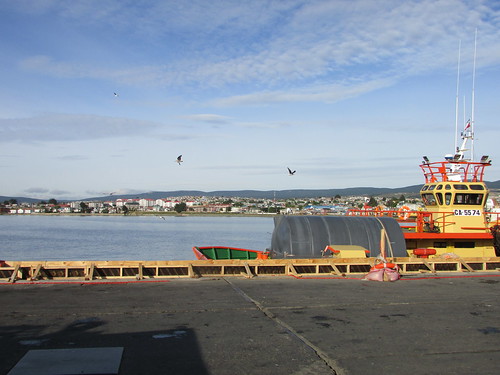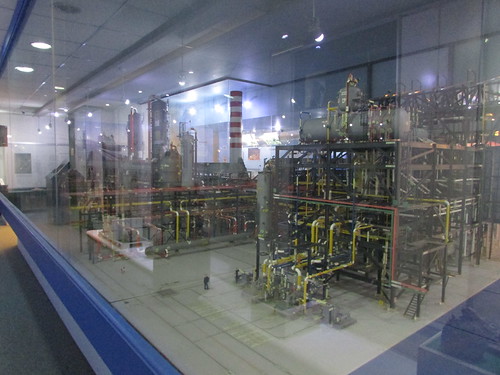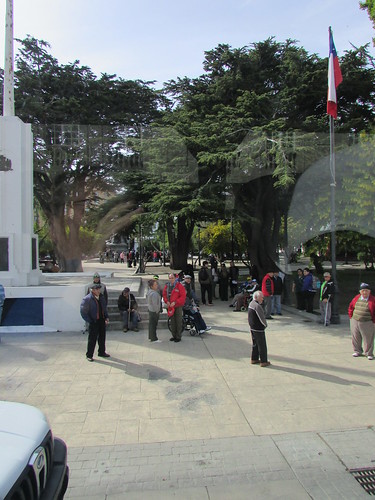I slept well with the ship moored against the jetty at Punta Arenas. My cabin on the port side was away from the quay, looking across the bay, so I was not disturbed by any lighting on the jetty. The programme offered a trip titled ‘Living Heritage in Punta Arenas’ by tour bus, lasting around 5 hours. By no means all of the guests took this trip – I think the duration discouraged some.
On leaving the ship at 8.00 a.m. we first had to walk to the landward end of the jetty past the activity on the dock where one cargo ship was unloading some sort of packaged marine-related product onto a curtain-sided lorry. At the gate I’d used the previous evening, we were then directed through the Punta Arenas Passenger Terminal (the inevitable steel-framed warehouse with souvenir shop) where we passed through a metal detector arch and all backpacks and similar hand-baggage was X-rayed. Two modern tour buses were waiting outside, each with an English-speaking local guide and members of the ship’s Expedition Team.

Punta Arenas tour: View of town from the jetty.
Punta Arenas is in the Region Magellianes and, because of the remoteness from Santiago, Chile’s capital, the region has its own local government and the people are fiercely independent. There is a regional flag and a popular movement for further independence.
The bus drove to a viewpoint on La Cruz Hill where we had a few minutes to admire the town laid out below us. Then we set off north through the town, just starting to come alive in the leisurely way I’ve come to expect on this continent. It was a surprise to see just how far the town has spread out around the bay – we must have travelled two or three miles on a dual carriageway before we came to the end of the development, passing attractive detached housing, schools, hospitals and university buildings. I believe that there are three state universities in Punta Arenas, plus private facilities. One university campus had an open air industrial museum attached. We turned back towards the town centre when we reached the military base near the Asmar site which appeared to be a ship repair yard (this is one of three shipyards operated by Asmar Shipyards in Chile - their website is here). On the way back, I had a good view of the public cemetery donated by the successful Braun family. The bus stopped outside the Maggiorino Borgatello Museum (the limit of my exploration the previous evening) and we spent a too-short 45 minutes touring the museum’s four sections.
Notes on the history of the museum
The indigenous peoples of the area around the Strait of Magellan and Tierra del Fuego were the Kaweskar, Tehuelches, Selk’nam and Yamanas. In the 19th century, the Jesuits promoted an initiative to these areas, the Salesian Mission, to convert the indigenous population to Christianity. In 1893, one of the priests, Maggiorino Borgatello and Coadjutor Angel Benove started the museum to form a record of the fast-disappearing indigenous cultures.
The first section of the museum deals with the archaeology, paleontology and fauna of Patagonia.
The second section covers the now-extinct indigenous peoples and the Salesian Mission.

Maggiorino Borgatello Museum: Part of the displays of artefacts of the indigenous peoples.
The third section presents a history of colonisation, immigration, evangelisation, the whaling industry and the exploration of the Antarctic and housing artefacts used by the indigenous cultures.
The last section deals with modern industrialisation of the region, covering the extraction of gas and oil and the development of aviation.

Maggiorino Borgatello Museum: A large model of a petrochemical plant.
The museum has a website here.
Plaza de Armas
After our brief museum visit I boarded our bus with some reluctance and we drove to the Plaza de Armas (which I’d also reached on foot the previous evening) where we had 30 minutes to explore. It was much busier than the previous evening but still with the same relaxed feeling. It was a warm, sunny day which, we were told, is very unusual for Punta Arenas where the normal weather is dull and overcast.

Punta Arenas tour: Plaza de Armas.
Our bus then continued south to the edge of town where we were to visit a sheep farm. On the way we passed two old ‘nodding donkey’ oil well pumps and a locomotive boiler displayed, near where the hulks of a number of old ships had been beached. The largest ship had four masts and what looked like an iron hull (later research revealed this as the 'County of Peebles', described on Wikipedia here and, a few hundred yards further south, the remains of 'Lord Lonsdale' detailed here on an interesting website called 'Wrecksite').

Punta Arenas tour: 'County of Peebles' in use as a breakwater.
El Galpon Estanza
The area we saw was a ‘demonstration farm’ but the owner who conducted the tour also has 30, 000 sheep! We were invited into a large, modern wooden barn with tables and seating for perhaps 100 which could clearly be used when required as a function room for full meals. Old farming and domestic artefacts were displayed everywhere. The was a display of a number of cast iron doors from old wood burning stoves and one large complete wood burning stove made by ‘Smith … Columbian Stove Works … London Liverpool Glasgow & London’ now just used as a serving table. After a brief introduction, the owner showed a short video on the history of the area and the introduction of sheep farming. The owner then led us up the hillside through a nature walk set up by him to re-introduce various local flora and past a small field with a group of sheep and llamas to another wooden barn set up to demonstrate sheep shearing.

El Galpon Estanza: The owner describes flora on our nature walk.
One end of the sheep shearing shed was provided with tiered wooden benches, theatre-style, to accommodate at least 100 people. This faced a shearing area with five shearing sets. One set had an electric ‘Lister Shearing 3-speed Shearing Set’ made after Lister became part of Hawker Siddeley which offered speeds of 2000, 2850 and 3200 r.p.m. (by manually shifting a drive belt connecting the motor pulley to the driven pulley). However, there was also an common overhead drive shaft to the shearing sets and a large single cylinder ‘Lister’ stationary water-cooled diesel engine which an elderly assistant laboriously hand-cranked into life, where upon the farm owner (who, it was becoming clear, was quite an enthusiast for preserving the old ways and equipment) slipped a drive belt around the Lister’s flywheel to power up the shearing sets connected to the overhead drive shaft. A retired shearer was then introduced to us and a sheep was brought in, which three minutes later had had its fleece removed in virtually one piece.

El Galpon Estanza: A demonstration of sheep shearing.
We were then invited into the other half of the shed which served as a garage for the farm owner’s collection of cars and an early ‘Evinrude’ outboard motor for boats which we were invited to examine.
The owner then led us to another similar wooden barn, this one laid out as a museum of the history of the area. What was particularly interesting was a section devoted to the owner’s family with photographs and artefacts.

El Galpon Estanza: Part of the owner's museum.
Finally, we returned to the first barn where we sat and were given drinks and a snack. Then it was back onto our two tour buses for the short drive back to the Passenger Terminal at the Port (which I believe is operated by EP Austral) and the walk along the jetty to ‘Silver Explorer’.
Leaving Punta Arenas
At our scheduled departure time,2.00 p.m., two tugs were standing by next to the ship – ‘Beagle’ which had attended our arrival the previous day and ‘Calafate’ (replacing ‘Pelicano II’ from the previous day), but bunkering was still in progress from a large, articulated tanker parked next to the ship. The tanker did not have pumping facilities so it was supported by a pick-up truck towing a rather home-made trailer. This trailer mounted a large automotive engine and gearbox coupled to a pump to transfer fuel via hoses from the tanker to the ship. Once pumping operations had finished, the ship prepared to leave.

Leaving Punta Arenas: 'Silver Explorer' prepares to leave after being replenished by lorry and tanker.
The tanker driver made rather a business out of reversing the articulated vehicle along the jetty, not made easier by the pick-up towing the pump trailer making rather a mess of turning round and then sneaking out ahead of the fuel tanker. As expected, no assistance was required from the tugs as the Captain manoeuvred the ship away from the quay. One puzzle was that a very noisy small tug ‘Atlas’ came bow-first against the opposite side of the jetty with power applied as we left, almost as if our departure was expected to displace the whole jetty sideways!
! Later in the afternoon, I attended Sheri Bluestein’s lecture titled ‘Cool Science in Cold Places’ outlining some of the research work being carried out at the various Antarctic Research Bases.
There was a special, short briefing at 6.15 p.m. where Kara announced a change of plan. Instead of following the originally-intended route to the Drake Passage via the Strait of Magellan, we were to follow an alternate channel through the islands of Terra del Fuego which was actually shorter and the time saved might allow us to have a closer look at Cape Horn, with the Chilean Navy’s blessing. All would depend upon wind and weather.
At 7.00 p.m. there was a Venetian Society cocktail party in the theatre. The Venetian Society is the charity set up by Silversea’s owners. Repeat travellers with Silversea are enrolled upon agreeing to a modest daily donation whilst on board.
For me, the last event of a busy and enjoyable day was dinner in the restaurant. Some guests liked to go on to the Panorama Lounge for a ‘nightcap’ but I usually spent some time sorting out photographs or writing text for my blog whilst the memory of the events was fresh.
Related Posts
Next post describing this trip: Cape Horn.
All posts describing this trip: Chilean Fjords.
My pictures
Where necessary, clicking on an image above will display an 'uncropped' view or, alternately, my pictures from this (and earlier) trips may be selected, viewed or downloaded, in various sizes, from the albums listed:-
Punta Arenas tour.
Maggiorino Borgatello Museum.
El Galpon Estanza.
Leaving Punta Arenas.
All my pictures of Chile can be found in the collection Chile.
[Links to pictures added, pictures added: 26-Jan-2017]
